The eighth installment of the “Planet of the Apes” franchise, Dawn of the Planet of the Apes, comes a long way from the original make-up and prosthetic effects of the 1968 original. The movie, out now and starring Gary Oldman, Keri Russell, and Andy Serkis, follows a group of genetically evolved apes, led by Caesar, as they are threatened by a group of human survivors following a devastating virus. Electronic Design talked with Joe Letteri, senior visual effects (VFX) supervisor of Weta Digital, which created all of the effects for the film. No spoilers, we promise!
Having previously worked on King Kong, Avatar, Lord of the Rings, and Rise of the Planet of the Apes, Weta is no stranger to the latest in VFX technology. In order to make the apes as realistic as possible, a combination of motion and performance capture technology and digital animation was used. Although Weta first took the technology (seen above) on location with Rise, they really went for it with Dawn—knocking out the kinks of moving from a soundstage to on-location, seen straight from the beginning when the film drops you in the middle of the apes’ world. With the technology, Letteri says they were able to “spotlight contemporary problems in a new way, showcasing the fears and desires of the apes in the most human way.”
Watch the video below for a behind-the-scenes look at the performance capture technology:
After the actors’ motions were captured, including all joints, limbs, and facial movements, the digital animators went in and added layers to imitate the real anatomy of apes—including their skeleton, muscles, fat, and skin. Specific attention was paid to skin color, texture, and pores as well as the exact muscle simulation of the animals. New to Dawn was technology that allowed for the rendering and building of light and depth in the apes’ eyes. Light was also digitally added to soak into the apes’ fur to further embed them into the scene.
The film’s 3D rendering had no effect on the VFX, as the animators were already working in 3D to develop the most realistic apes possible. Weta was an integral part of the film’s conception and development from the beginning, consulting on the design process with concept art for weapons, costumes, and even story ideas. So what is Letteri’s favorite scene in the film? The day scenes shot in the apes’ village in which the animators worked hard to create a small, natural, and lived-in moment with a strong sense of comraderie. After all, the apes are just like us.

